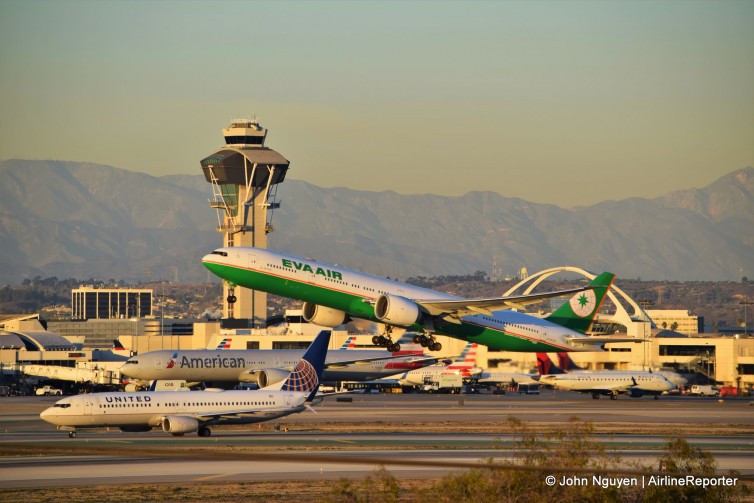
LAX at sunset
I would be willing to wager that most of the traveling public simply buys whatever airfare suits them best to get from Point A to Point B, and probably back to Point A. Whether it be the ever-popular nonstop, the obvious geographic connection, the shortest connecting time, and/or simply the lowest price, most people don’t really think outside the box when it comes to booking tickets. The carriers rely on the fact that customers will simply select from among the first few options they see when booking online; as such, there have been PR battles and even lawsuits over what order online travel booking sites list certain fares and airlines.
What you may not know is that fare rules (you know, those long-winded, multi-page things full of legal mumbo-jumbo you never read before clicking the box saying you agree to them and purchasing the ticket) many times have built-in flexibility that’s just waiting to be utilized for maximum effect, even on the cheapest fares…
Before finalizing your next ticket purchase, it may be worth checking out whether you can stay in your connection city on for a few days (known as a “stopover”), especially if it’s a city you enjoy or have never been to before. Even if a stopover isn’t allowed, sometimes a long layover is permitted. There are things to keep in mind to better understanding the process.

Cherry blossoms (sakura) bloom in Shinjuku Gardens in Tokyo – Photo: John Nguyen | AirlineReporter
Embracing the Connection: Basic Rules
While each fare between different cities, on different airlines, and even on different days will have different rules, there are general rules that apply to many, if not most, fares, especially on the “traditional” carriers (low-cost carriers such as Spirit, Ryanair, easyJet, and Air Asia tend to break this mold, so we’ll leave them out of this discussion). Also, this discussion will admittedly be U.S.-centric, but the general principles apply everywhere.

Overlooking the Schonbrunn Palace and the Vienna skyline – Photo: John Nguyen | AirlineReporter
The first important distinction is whether you will be flying an international or domestic trip, especially from a U.S. airport. This changes the definition of the second important concept: a layover versus a stopover. Layovers don’t increase the fare price because it’s considered part of a single ticket, whereas stopovers will break the fare into two separate tickets.
- On a domestic fare, airlines will allow customers four hours at a connecting airport to catch the next flight and still consider it a layover and not a stopover. Note that there are other rules regarding allowed routings, next available flight, last-in/first-out situations, etc., but we’ll save that for another discussion.
- On international itineraries (anything with a flight to a foreign country along the way), the airlines allow up to 24 hours for the passenger to connect to their next flight, whether or not that next flight is another domestic flight or an international segment.
To illustrate the above concepts, let’s take a hypothetical trip from Los Angeles (airport code: LAX) to Miami (MIA), with a typical connection in Dallas-Fort Worth (DFW). This is a domestic trip and thus once you arrive in DFW, you are allowed four hours to connect onto a flight to MIA, giving you a decent range on whether you’d like to rush to the next flight or relax a bit, but either way you’re not likely to leave DFW airport.
However, on a different hypothetical trip from LAX to London-Heathrow (LHR), but also connecting at DFW, you are given up 24 hours to make the connection. Of course, there are nonstop flights between LAX and LHR, and on the connection you’d likely choose to take the next available DFW-LHR flight within a couple of hours to minimize total travel time. However, if you choose spend the night in Dallas and take a flight the next day (within 24 hours of arriving), your base fare won’t change (with small changes to taxes and fees). For many frequent flyers, spending a night in the Dallas may not sound so great, but for someone who’s never been to Dallas, has friends in Dallas to visit or grab a meal with, or some other reason to spend more time in Dallas, this may be a great opportunity. And this opportunity applies for any connection city, not just Dallas.

Kinkaku-ji in Kyoto, Japan – Photo: John Nguyen | AirlineReporter
Given the additional flexibility of international fares, we’ll continue our discussion focused on those. The next concept is one of those fancy business school terms: scalability. To better understand how you can scale your connection(s), it’s easier to illustrate it using real-life examples.
Embracing the Connection: A Real-Life Demonstration
Being based in the U.S., I primarily fly American Airlines, especially to get to an Asia gateway airport on my way to visit friends and relatives in Vietnam. I scale up the 24-hour connection rule by intentionally adding more connection points, both in the U.S. and abroad. So long as I spend 23 hours, 59 minutes or less at a given connection airport, the base fare will remain unchanged.

Street food at a night market in Taipei – Photo: John Nguyen | AirlineReporter
I’ll illustrate with an actual airfare search using ITASoftware, which is the more primitive precursor to Google Flights. Say you are starting at DFW and connecting in Tokyo-Narita (NRT) on your way to Saigon (SGN), a typical sample itinerary may look something like this:
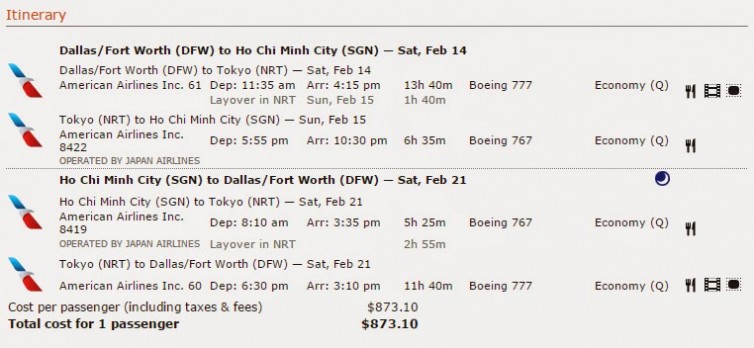
Image: ITASoftware
A standard round-trip, with same-day connections — nothing out of the ordinary — prices out at $873.
Now, say you wanted to stop in Los Angeles for whatever reason; this is what happens when I price the itinerary with an overnight layover at LAX:
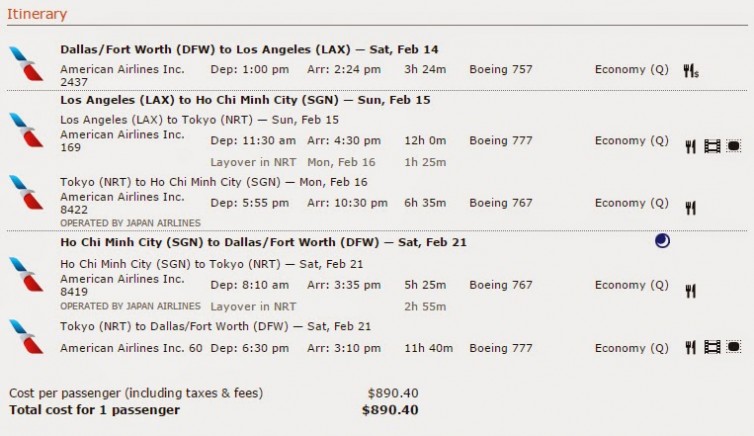
Image: ITASoftware
Notice that I’m scheduled to spend about 21 hours in Los Angeles, starting in the late afternoon and overnight, giving me enough time to pick up my rental car, head to the beach for a couple of hours, grab dinner, get plenty of sleep, go for a run along another beach, and have a decent breakfast, all before heading back to LAX to hop on my onward flight to NRT… all this for the fare price of $890, or a mere $17 increase from the original boring itinerary, which is just the difference in taxes and airport fees. If you’re lucky, AA may even check your luggage all the way to SGN, so you don’t have to deal with it on your long layovers.
This is what happens if I decide to spend a few extra hours in Tokyo (on top of my jaunt through Los Angeles) before heading to Saigon:
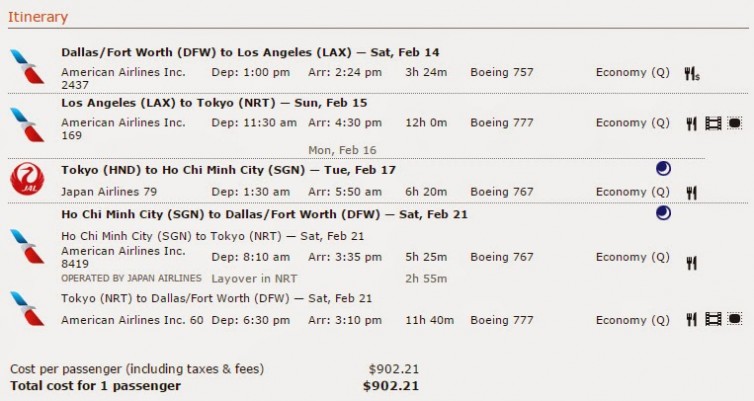
Image: ITASoftware
Instead of a 1.5 hour connection in Tokyo, I now have nine hours to visit, and it only added $12 to the original total. Granted, there’s a change in airport, but nine hours is plenty of time to be able to get a feel for the city before heading to Haneda Airport (HND), which is situated much closer to the central city areas.
Embracing the Connection: Let’s Get Crazy
Finally, if you wanted to go all crazy on both the outbound and return legs, this is an example of what you can do:
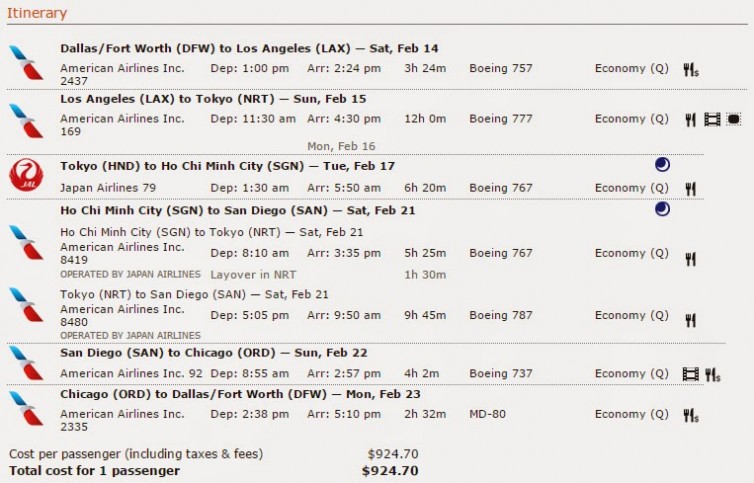
Image: ITASoftware
As you can see here, on the way home to DFW, I added a layover just shy of 24 hours in San Diego, and a 23-hour, 19-minute layover in Chicago, all for a mere $51 increase from the original boring itinerary! In fact, you can get even more creative, since connections do not have to be at the hubs, but can be at outstations that two hubs both service – e.g., instead of flying DFW-LAX direct, you could connect in Denver, Phoenix, El Paso, Santa Fe, Las Vegas, Austin, and so on, since all those cities have direct flights to DFW as well LAX… and yes, the 24-hour connection rule apply to those connections as well.
Scalability….
Obviously, this type of trip isn’t for everyone. I personally enjoy having the opportunity to visit cities I’d otherwise pass through. I figure if I’m going to fly hours to get to some city, why not leave the airport for a little bit?

Peking duck prepared tableside in Hong Kong – Photo: John Nguyen | AirlineReporter
There are a few caveats to be aware of:
- Most international tickets have a “maximum permitted mileage” restriction, or the maximum distance you can fly between the two points. Some backtracking is usually okay; going the long way around the globe is usually not okay.
- There may also be a limit on the number of connections, e.g., two per direction, but otherwise, it might also be unlimited.
- The same fare class (indicated as a “Q” fare class in the examples above) must be available on each of your flight segments for the base fare to price out.
- Individual fare rules dictate layover maximum, number of connections allowed, etc.
- Remember to keep it at 23 hours, 59 minutes or under. If you hit the 24-hour mark, your connection becomes a stopover, which may trigger a stopover fee or break the fare into two separate (and usually more expensive) fares.
- You’ll actually have to price and ticket this itinerary either by manipulating AA.com or another travel site, using the “multi-city search” feature, or by having an AA agent (phone or airport) ticket what you want. Having a real-life agent involved will likely incur a fee.
- Remember that this layover “trick” exists on many other airlines as well, though your experience may vary.
If you know the rules, you can fully maximize your trip potential without adding much cost. It’s a great way to experience new cities, or revisit favorite ones.

Quite possibly one of the most Swiss photos ever taken – Photo: John Nguyen | AirlineReporter
And FYI, all the photos you see in this piece are of places I visited using the under-24-hour connection!
PIMP your airfare? Is that the only way you could have put it? Very unprofessional.
Hey Kevin,
I think it is more about having a sense of humor than professionalism. We aim more to entertain than to win a Pulitzer Prize.
Either way, I hope that it didn’t cause you to not read the story — I think Johnny did a great job with the story!
David | Editor-in-Chief | AirlineReporter
Kevin, definitely meant to be tongue-in-cheek, referencing a popular reality TV show called “Pimp My Ride.” Love it or hate it, the word has become part of the modern-day vernacular. I hope you found the information in the article otherwise useful.
John | AirlineReporter
John, I absolutely love this educational piece. I’ve yet to venture outside of the states via plane (it’s coming!) BUT this looks like something I could totally get on board with. As for the title, tongue-in-cheek is fine by me. And let’s be honest, you are putting the airfare to work, so the choice of words seems appropriate.
JL, you’re exactly my target demographic! My contention is that most people who book international trips, especially first-timers, have their eye on their prize, as it should be… but presuming that one has already taken several days off of work or other responsibilities, why not add on some bonus destinations? It could be anything from having afternoon tea in London to walking among the cherry blossoms in Tokyo to eating some fantastic BBQ in Kansas City. Next I’ll I’ll be visiting some family in NYC on my way to Europe; following that, my wife and I will be visiting some older relatives in Dallas on our way to Europe.
While it may not be limitless, it definitely feels like it.
John | AirlineReporter
I am a huge fan of doing this. So far I have done London twice and Frankfurt and Munich once each. Up next is Dublin.
Xnuiem, that’s great to hear! Just curious, how did you first learn about extending your connection? Did you read it somewhere/someone told you, or did you discover it on your own?
John | AirlineReporter
Figured it out playing around on airline sites.
I travel across the pond a lot for work, and am done with work early early am on Saturday. But by staying Saturday night somewhere, DUB, LHR, FRA, MUC, MAD, AMS, etc…the roundtrip airfare was usually 2-3K less (in J). Hotel, meal, and uber costs no where near that and I get ~24 hours to explore a new city. Win for everyone!
#Winning! As you were able to demonstrate, flexibility and playing around with schedules can net you quite the windfall. Obviously not for everyone (e.g., those on a business trip with a structured itinerary and time restrictions), but even just a little bit of flexibility can go a long way. Even for business trips, I’m sure supervisors would be thrilled at hearing about the cost savings (so long as it doesn’t impede productivity, of course). Thank you for sharing your thoughts!
John | AirlineReporter
Great post. One other unmentioned benefit of doing this is adding a bit of stress relief – I always look to add time in connection cities as a backup in case something goes wrong. We flew through London recently on our way to Austria. Flight into London was 3 hours late, which would have meant missing the “easy” connection to the last flight of the day at 5pm, scrambling to find hotel, get re-accommodated, etc. Instead, we just had 3 hours in the lounge in DFW and a little less time to explore London before our scheduled flight out the next day. Not a big deal.
This is a great point Andy. Scheduling a long layover opens up options. As you mentioned, it provides a buffer should your incoming flight be delayed. And if the flight is on-time, then that’s just even more time to explore. Travel should be fun and stressfree, and sweating out a short connection is never fun. Thanks for sharing!
John | AirlineReporter
Dear author, thank you aplenty for shedding some light to this (unknown to me) technique of spreading out the long haul travel and have some more fun in the process and exploration of new and interesting destinations. I guess airports should consciously start giving out this information so that their host cities can benefit from this short stay crowd. Plus these same travellers will come for longer durations to those cities later on in life.
Hey Atul,
It’s like you read my mind! 🙂 It definitely is a good way to “sample” different cities to see if it’s someplace to come back to later on.
John | AirlineReporter
UNREAL information here. I have never heard of this before, but something I wish I knew a loooong time ago. Just the thought of staying overnight in a hotel and getting a good nights sleep sounds like a bonus to me, apart from exploring a new city. I cannot sleep well on long haul flights so a good sleep in between will be very welcome and relaxing, I would feel refreshed to continue the onward journey the following day…thanks for sharing John….
Thanks, Rachel!
Breaking up a long trip to get some sleep in a hotel is another great use of this, especially between two long trips. It’s worth a separate post, but many international airlines offer a free hotel room (or a tour) during long layovers, so it may be worth Googling. Not being stressed while traveling is so important in maintaining one’s sanity and just enjoying the adventure.
John | AirlineReporter
As I website possessor I conceive the content material here
is rattling great, thanks for your efforts.
I usually do not write many comments, but i did a few searching and wound up here Pimp Your Airfare: Embrace
the Connection – AirlineReporter : AirlineReporter. And I
do have 2 questions for you if it’s allright.
Could it be simply me or does it look as if like some of the comments come across like they are coming from brain dead people?
😛 And, if you are writing at additional online sites, I’d like to follow anything new you have to post.
Could you make a list of the complete urls of your shared pages like your Facebook page, twitter feed,
or linkedin profile?
This web site really has all the information and facts I wanted concerning this
subject and didn?t know who to ask.
Thanks for sharing your thoughts on colon clensing.
Regards
Outstanding post, you have pointed out some excellent details, I also think this
is a very good website.
Have you ever considered writing an ebook or guest authoring on other blogs?
I have a blog centered on the same information you discuss and would love to have you share some stories/information. I know
my subscribers would value your work. If you’re even remotely interested, feel free to send me an e-mail.
HÑ– theгe colleagues, Ñ–tÑ• wonderful paragraph about tutoringand fully explained, Òeep Ñ–t
up all the timе.